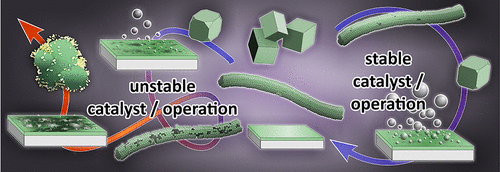当前位置:
X-MOL 学术
›
Acc. Chem. Res.
›
论文详情
Our official English website, www.x-mol.net, welcomes your feedback! (Note: you will need to create a separate account there.)
Catalytic Stability Studies Employing Dedicated Model Catalysts.
Accounts of Chemical Research ( IF 18.3 ) Pub Date : 2020-01-22 , DOI: 10.1021/acs.accounts.9b00467 Franziska Hess 1, 2, 3 , Bernd M Smarsly 1 , Herbert Over 1
Accounts of Chemical Research ( IF 18.3 ) Pub Date : 2020-01-22 , DOI: 10.1021/acs.accounts.9b00467 Franziska Hess 1, 2, 3 , Bernd M Smarsly 1 , Herbert Over 1
Affiliation

|
Long-term stability of heterogeneous catalysts is an omnipresent and pressing concern in industrial processes. Catalysts with high activity and selectivity can be searched for by high-throughput screening methods based maybe on educated guesses provided by ab initio thermodynamics or scaling relations. However, high-throughput screening is not feasible and is hardly able to identify long-term stable catalyst so that a rational and knowledge-driven approach is called for to identify potentially stable and active catalysts. Unfortunately, our current microscopic understanding on stability issues is quite poor. We propose that this gap in knowledge can be at least partly closed by investigating dedicated model catalyst materials with well-defined morphology that allow for a tight link to theory and the application of standard characterization methods. This topic is highly interdisciplinary, combining sophisticated inorganic synthesis with catalysis research, surface chemistry, and powerful theoretical modeling. In this Account, we focus on the stability issues of Deacon catalysts (RuO2 and CeO2-based materials) for recovering Cl2 from HCl by aerobic oxidation and how to deepen our microscopic insight into the underlying processes. The main stability problems under harsh Deacon reaction conditions concomitant with a substantial loss in activity arise from deep chlorination of the catalyst, leaching of volatile chlorides and oxychlorides, and decrease in active surface area by particle sintering. In general, powder materials with undefined particle shape are not well suited for examining catalyst stability, because changes in the morphology are difficult to recognize, for instance, by electron microscopy. Rather, we focus here on model materials with well-defined starting morphologies, including electrospun nanofibers, shape-controlled nanoparticles, and well-defined ultrathin crystalline layers. CeO2 is able to stabilize shape-controlled particles, exposing a single facet orientation so that comparing activity and stability studies can reveal structure sensitive properties. We develop a quasi-steady-state kinetic approach that allows us to model the catalyst chlorination as a function of temperature and gas feed composition. For the case of pure CeO2 nanocubes, this simple approach predicts chlorination to be efficiently suppressed by addition of little amounts of water in the reaction feed or by keeping the catalyst at higher temperature. Both process parameters have great impact on the actual reactor design. Thermal stabilization of CeO2 by intermixing Zr has been known in automotive exhaust catalysis for decades, but this does not necessarily imply also chemical stabilization of CeO2 against bulk-chlorination since Zr can readily form volatile ZrCl4 and may quickly lose its stabilizing effect. Nevertheless, with model experiments the stabilizing effect of Zr in the Deacon process over mixed CexZr1-xO2 nanorods is clearly evidenced. Even higher stability can be accomplished with ultrathin CeO2 coatings on preformed ZrO2 particles, demonstrating the great promise of atomic layer deposition (ALD) in catalysis synthesis.
中文翻译:

使用专用模型催化剂的催化稳定性研究。
非均相催化剂的长期稳定性是工业过程中无所不在且紧迫的问题。可以基于从头算热力学或比例关系提供的有根据的猜测,通过高通量筛选方法来搜索具有高活性和选择性的催化剂。然而,高通量筛选是不可行的,并且几乎不能识别长期稳定的催化剂,因此需要一种理性且知识驱动的方法来识别潜在的稳定和活性催化剂。不幸的是,我们目前对稳定性问题的微观理解还很差。我们建议,通过研究具有明确定义的形态的专用模型催化剂材料,可以至少部分地弥补这一知识差距,从而可以与理论和标准表征方法紧密联系。该主题是高度交叉学科,将复杂的无机合成与催化研究,表面化学和强大的理论建模相结合。在此帐户中,我们重点关注通过好氧氧化从HCl中回收Cl2的迪肯催化剂(RuO2和CeO2基材料)的稳定性问题,以及如何加深我们对潜在过程的微观认识。在苛刻的迪肯反应条件下,主要的稳定性问题伴随着活性的显着降低,这是由于催化剂的深度氯化,挥发性氯化物和氯氧化物的浸出以及颗粒烧结导致活性表面积降低而引起的。通常,具有不确定形状的粉末材料不适用于检查催化剂的稳定性,因为形态变化很难识别,例如,通过电子显微镜。而是,我们将重点放在具有明确起始形态的模型材料上,包括电纺纳米纤维,形状受控的纳米粒子和明确定义的超薄晶体层。CeO2能够稳定形状受控的颗粒,暴露出一个小平面方向,因此比较活性和稳定性研究可以揭示结构敏感的特性。我们开发了一种准稳态动力学方法,该方法使我们能够根据温度和气体进料组成对催化剂氯化进行建模。对于纯CeO2纳米立方体而言,这种简单的方法预计通过在反应进料中添加少量水或将催化剂保持在较高的温度下,可有效抑制氯化反应。这两个工艺参数对实际反应器设计都有很大影响。通过混合Zr对CeO2进行热稳定在汽车尾气催化中已为数十年之久,但这并不一定意味着对CeO2进行化学稳定以防止大量氯化,因为Zr容易形成挥发性ZrCl4,并可能很快失去其稳定作用。然而,通过模型实验,清楚地证明了Zr在Deacon过程中对混合的CexZr1-xO2纳米棒的稳定作用。预先形成的ZrO2颗粒上的超薄CeO2涂层可以实现更高的稳定性,这证明了催化合成中原子层沉积(ALD)的巨大前景。但这并不一定意味着CeO2的化学稳定能抵抗大量氯化反应,因为Zr容易形成挥发性ZrCl4,并可能很快失去其稳定作用。然而,通过模型实验,清楚地证明了Zr在Deacon过程中对混合的CexZr1-xO2纳米棒的稳定作用。预先形成的ZrO2颗粒上的超薄CeO2涂层可以实现更高的稳定性,这证明了催化合成中原子层沉积(ALD)的巨大前景。但这并不一定意味着CeO2的化学稳定能抵抗大量氯化反应,因为Zr容易形成挥发性ZrCl4,并可能很快失去其稳定作用。然而,通过模型实验,清楚地证明了Zr在Deacon过程中对混合的CexZr1-xO2纳米棒的稳定作用。预先形成的ZrO2颗粒上的超薄CeO2涂层可以实现更高的稳定性,这证明了催化合成中原子层沉积(ALD)的巨大前景。
更新日期:2020-01-23
中文翻译:

使用专用模型催化剂的催化稳定性研究。
非均相催化剂的长期稳定性是工业过程中无所不在且紧迫的问题。可以基于从头算热力学或比例关系提供的有根据的猜测,通过高通量筛选方法来搜索具有高活性和选择性的催化剂。然而,高通量筛选是不可行的,并且几乎不能识别长期稳定的催化剂,因此需要一种理性且知识驱动的方法来识别潜在的稳定和活性催化剂。不幸的是,我们目前对稳定性问题的微观理解还很差。我们建议,通过研究具有明确定义的形态的专用模型催化剂材料,可以至少部分地弥补这一知识差距,从而可以与理论和标准表征方法紧密联系。该主题是高度交叉学科,将复杂的无机合成与催化研究,表面化学和强大的理论建模相结合。在此帐户中,我们重点关注通过好氧氧化从HCl中回收Cl2的迪肯催化剂(RuO2和CeO2基材料)的稳定性问题,以及如何加深我们对潜在过程的微观认识。在苛刻的迪肯反应条件下,主要的稳定性问题伴随着活性的显着降低,这是由于催化剂的深度氯化,挥发性氯化物和氯氧化物的浸出以及颗粒烧结导致活性表面积降低而引起的。通常,具有不确定形状的粉末材料不适用于检查催化剂的稳定性,因为形态变化很难识别,例如,通过电子显微镜。而是,我们将重点放在具有明确起始形态的模型材料上,包括电纺纳米纤维,形状受控的纳米粒子和明确定义的超薄晶体层。CeO2能够稳定形状受控的颗粒,暴露出一个小平面方向,因此比较活性和稳定性研究可以揭示结构敏感的特性。我们开发了一种准稳态动力学方法,该方法使我们能够根据温度和气体进料组成对催化剂氯化进行建模。对于纯CeO2纳米立方体而言,这种简单的方法预计通过在反应进料中添加少量水或将催化剂保持在较高的温度下,可有效抑制氯化反应。这两个工艺参数对实际反应器设计都有很大影响。通过混合Zr对CeO2进行热稳定在汽车尾气催化中已为数十年之久,但这并不一定意味着对CeO2进行化学稳定以防止大量氯化,因为Zr容易形成挥发性ZrCl4,并可能很快失去其稳定作用。然而,通过模型实验,清楚地证明了Zr在Deacon过程中对混合的CexZr1-xO2纳米棒的稳定作用。预先形成的ZrO2颗粒上的超薄CeO2涂层可以实现更高的稳定性,这证明了催化合成中原子层沉积(ALD)的巨大前景。但这并不一定意味着CeO2的化学稳定能抵抗大量氯化反应,因为Zr容易形成挥发性ZrCl4,并可能很快失去其稳定作用。然而,通过模型实验,清楚地证明了Zr在Deacon过程中对混合的CexZr1-xO2纳米棒的稳定作用。预先形成的ZrO2颗粒上的超薄CeO2涂层可以实现更高的稳定性,这证明了催化合成中原子层沉积(ALD)的巨大前景。但这并不一定意味着CeO2的化学稳定能抵抗大量氯化反应,因为Zr容易形成挥发性ZrCl4,并可能很快失去其稳定作用。然而,通过模型实验,清楚地证明了Zr在Deacon过程中对混合的CexZr1-xO2纳米棒的稳定作用。预先形成的ZrO2颗粒上的超薄CeO2涂层可以实现更高的稳定性,这证明了催化合成中原子层沉积(ALD)的巨大前景。


























 京公网安备 11010802027423号
京公网安备 11010802027423号